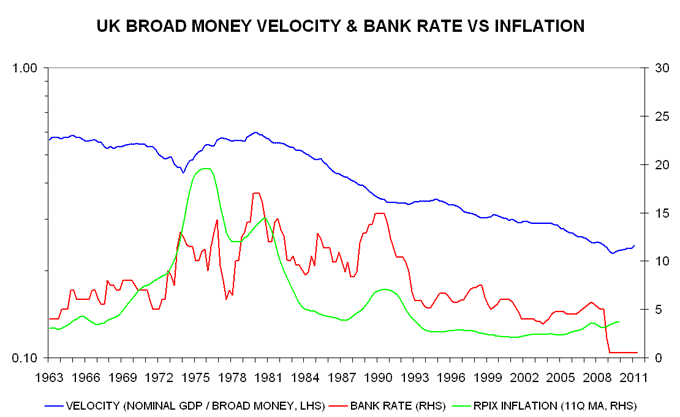The MPC is wrong to ignore rising monetary velocity
During 2009 and 2010 many commentators argued that UK broad money supply growth was too low, implying that the economic recovery would fail and / or inflation would undershoot the target. The counterargument deployed here was the velocity of circulation (i.e. the rate at which the existing stock of broad money turns over) was likely to rise in response to negative real interest rates. (A rise in velocity has the same economic impact as money supply expansion.) Nominal GDP growth, therefore, was more likely to be too strong than too weak.
Sufficient time has elapsed to make a preliminary judgement on this issue and it is unfavourable to the monetary pessimists. From a trough in the second quarter of 2009, nominal GDP rose by 9.1% by the first quarter of 2011 while broad money (i.e. M4 excluding holdings of “intermediate other financial corporations”) grew by 2.4%. The velocity of circulation, therefore, rose by 6.5%, or 3.7% at an annualised rate.
The current disappointing economic environment is the result not of insufficient nominal GDP expansion – the 9.1% increase annualises to a 5.1% growth rate over the seven quarters – but rather an unfavourable split between real activity and inflation.
In his Mansion House speech last week, Bank of England Governor Sir Mervyn King claimed that the recovery in real GDP would have been weaker if the MPC had reduced the degree of monetary policy stimulus in response to evidence that inflation was embarking on a sustained overshoot of the target. This claim is suspect. Less expansionary policy would have lowered the rise in nominal GDP but would probably have resulted in a more favourable activity / inflation split, suggesting real growth little different and possibly higher than actually achieved. A stronger pound resulting from MPC policy action, for example, would have lowered import price inflation, allowing a greater proportion of consumers' budgets to be spent on domestic goods and services.
Sir Mervyn failed even to acknowledge the large increase in velocity since 2009 in his latest speech, in which he again cited slow monetary expansion as a reason for inflation optimism*. The MPC is wrong to ignore the possibility that velocity is now on a rising trend. The chart shows the nominal GDP / broad money ratio since the early 1960s together with official interest rates and a smoothed measure of inflation. Following a similar cross-over of the inflation measure above official rates in the mid 1970s, velocity embarked on an increase of 38.6% over six years (i.e. 5.6% per annum), resuming its long-run downward trend only after positive real interest rates were restored in the early 1980s.
Absent a significant narrowing of the inflation / interest rate gap, velocity is likely to continue to rise, albeit less rapidly than in the 1970s when real rates were more negative than now. Assuming that the 3.7% annualised rate of increase since the second quarter of 2009 is sustained, broad money growth of 1-2% per annum is sufficient to support trend economic expansion and 2% inflation, and may even be too high. Suggestions that the MPC should embark on another round of QE in order to boost monetary growth, therefore, are dangerous – such an initiative would probably entrench or extend the current inflation overshoot, in part by putting renewed downward pressure on sterling as newly-created "excess" money is exported.
* "So far, subdued rates of increase in average earnings, as well as remarkably – some might say disturbingly – low growth rates of broad money have provided strong signals that inflation will fall back in due course." M4 excluding intermediate OFCs rose by 1.5% in the year to April.

Reader Comments